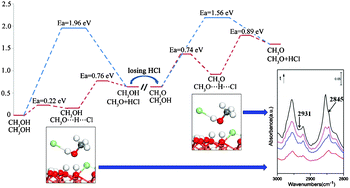DFT and DRIFTS studies of the oxidative carbonylation of methanol over γ-Cu2Cl(OH)3: the influence of Cl†
Abstract
This paper describes a detailed fundamental study regarding the influence of Cl species in γ-Cu(OH)3Cl catalyzed oxidative

* Corresponding authors
a
Key Laboratory for Green Chemical Technology of Ministry of Education, School of Chemical Engineering and Technology, Tianjin University, Tianjin, China
E-mail:
xbma@tju.edu.cn
Fax: +86-22-87401818
This paper describes a detailed fundamental study regarding the influence of Cl species in γ-Cu(OH)3Cl catalyzed oxidative

 Please wait while we load your content...
Something went wrong. Try again?
Please wait while we load your content...
Something went wrong. Try again?
Q. Meng, Z. Wang, Y. Shen, B. Yan, S. Wang and X. Ma, RSC Adv., 2012, 2, 8752 DOI: 10.1039/C2RA20570J
To request permission to reproduce material from this article, please go to the Copyright Clearance Center request page.
If you are an author contributing to an RSC publication, you do not need to request permission provided correct acknowledgement is given.
If you are the author of this article, you do not need to request permission to reproduce figures and diagrams provided correct acknowledgement is given. If you want to reproduce the whole article in a third-party publication (excluding your thesis/dissertation for which permission is not required) please go to the Copyright Clearance Center request page.
Read more about how to correctly acknowledge RSC content.
 Fetching data from CrossRef.
Fetching data from CrossRef.
This may take some time to load.
Loading related content
